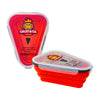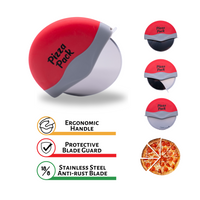Summary:
- Learn how to make pizza on a stovetop or grill without needing a traditional oven.
- Stovetop pizza cooks fast in a heavy pan, while grilled pizza gains a smoky, charred flavor.
- Key steps: Preheat your pan or grill, cook the dough first, flip and top, then cover to melt cheese.
- Essential tips include keeping toppings light, pre-cooking dense ingredients, and finishing with fresh herbs or oil.
- Store your leftovers in a collapsible pizza storage container to keep slices fresh and prevent soggy crusts.
Is a pizza oven the only way to get crispy crust and melty cheese? Think again. With a stovetop or a grill, you can make pizza that’s just as satisfying and sometimes even better. Both methods bring unique advantages: stovetop pizzas cook quickly with minimal equipment, while grilled pizzas pick up smoky, charred flavors you simply cannot replicate indoors.
These methods are faster than traditional baking, ideal for small kitchens, and perfect for summer evenings when turning on the oven feels unbearable. To master these pizza techniques, you must manage your kitchen space as carefully as your heat. If you’re looking for clever ways to organize and maximize storage for those fresh toppings, look at these space-saving hacks for small fridges.
Key Tips: Use the right pan or grill setup, keep your toppings light, and manage the heat carefully.
How to Make Stovetop Pizza
Cooking pizza on the stovetop is all about quick, even heat and smart timing. Done right, it gives you a crust that is golden on the outside and soft on the inside.
Step 1: Prep the dough
Roll your dough slightly smaller than the size of your pan. This ensures it fits comfortably and leaves room for the crust to rise. Have all your toppings ready, such as sauce, cheese, herbs, and pre-cooked meats, so you can add them quickly once the crust is cooking. If you want to improve your base, this guide to perfect pizza dough at home explains recipes and tips for storing extra dough in a Pizza Pack.
Step 2: Heat the pan
Place a nonstick or cast-iron pan on medium-high heat. Add a thin layer of oil and wait until it shimmers. This step prevents sticking and helps develop that signature crisp bottom.
Step 3: Cook the dough
Lay the dough flat in the pan. Let it cook for 1–2 minutes until golden spots form and the surface starts to bubble.
Step 4: Flip and top
Turn the dough over with a spatula. Immediately spread sauce, sprinkle cheese, and add toppings. Work quickly so the bottom does not burn.
Step 5: Melt the cheese
Cover the pan with a lid, reduce the heat to medium-low, and cook for another 5 minutes. The trapped steam melts the cheese and heats the toppings evenly.
Step 6: Crisp under the broiler (Optional)
If you want extra crunch, slide the pizza under the broiler for 1–2 minutes. For leftovers, here is how to reheat pizza without making it soggy, so every slice keeps its texture.
Pro Tip: Nonstick and cast-iron pans are the most reliable for stovetop pizzas. Avoid overloading toppings because too much weight can prevent the crust from cooking properly.
How to Make Grilled Pizza
Grilling pizza brings the experience outdoors and adds a smoky depth. Once you try it, you may never go back.
Step 1: Preheat the grill
Set your grill to 400–500°F. High, steady heat is the secret to achieving those classic grill marks without drying out the crust.
Step 2: Prep the dough
Brush one side of your stretched dough lightly with oil. This keeps it from sticking and helps develop color on the grill.
Step 3: Grill the first side
Lay the oiled side directly on the grates. Cook for about 2 minutes until you see distinct grill marks and the dough starts to firm up.
Step 4: Flip and top
Flip the dough so the grilled side is facing up. Spread sauce, sprinkle cheese, and add toppings while the underside cooks.
Step 5: Finish cooking
Close the grill lid and cook for another 5–7 minutes. The closed grill acts like an oven, allowing the cheese to melt and the toppings to heat evenly.
Pro Tip: If possible, use both direct and indirect heat zones. Start on direct heat for grill marks, then shift to indirect to avoid burning the crust before the cheese melts.
Essential Tips for Both Methods
Whether cooking indoors or outdoors, a few universal tips make all the difference:
Choose the right dough: Both store-bought and homemade doughs work. If making your own, stretch it thin enough to cook through quickly.
Less is more with toppings: Overloaded pizzas are harder to cook evenly. Pre-cook meats and dense veggies like mushrooms or peppers to prevent sogginess.
Finish with fresh touches: Add basil leaves, chili flakes, or a drizzle of olive oil after cooking to enhance flavor and presentation.
Think ahead for storage: Homemade pizza often leaves leftovers. That is when having a collapsible pizza storage container becomes invaluable. It keeps slices separate, airtight, and ready for reheating later. For more ideas, explore these storage tips for leftover pizza.
Conclusion
Making pizza does not have to rely on an oven. Stovetop and grill methods offer flexibility, speed, and flavor that rival traditional baking. They are perfect for busy weeknights, small kitchens, or summer cookouts when you want something fun and different.
Both approaches invite experimentation. Try unique toppings, play with sauces, or even make personal-sized pizzas so everyone can customize their own. Most importantly, enjoy the process because pizza is as much about creativity as it is about taste.
Ready to try stovetop or grilled pizza? Explore the Pizza Pack collection to ensure your next homemade creation stays fresh, flavorful, and ready for round two.
FAQs
Can I make pizza without an oven? Yes, use a stovetop pan or grill for crispy, delicious pizza in minutes.
What’s the best pan for stovetop pizza? A heavy nonstick or cast-iron pan works best for even heat and crisp crusts.
How do I keep grilled pizza from burning? Use direct heat to sear, then indirect heat to finish cooking with the lid closed.
What toppings work for these methods? Light, pre-cooked toppings like veggies or sausage prevent sogginess.
How do I store homemade pizza? Pizza Pack’s airtight containers keep your pizza fresh in the fridge or freezer.





